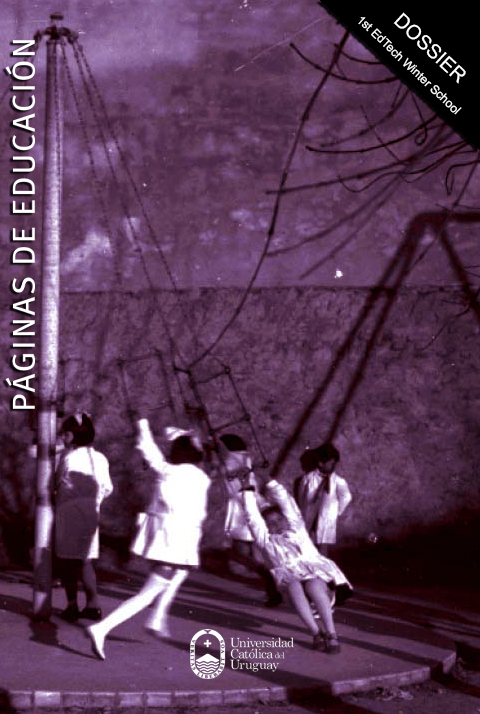¿Qué hay de nuevo en las noticias falsas? Alfabetizaciones digitales críticas en la era de las noticias falsas, la posverdad y el cebo de clics
DOI:
https://doi.org/10.22235/pe.v11i1.1551Palabras clave:
alfabetismos digitales esenciales, noticias falsas, plataformas digitales, redes socialesResumen
El escándalo de noticias falsas de Facebook de 2016 puso de relieve la dificultad para determinar la credibilidad y la confiabilidad de las noticias. Como resultado, se instó a individuos a que adoptaran una posición más informada y crítica frente de la fuente de sus noticias. El presente trabajo considera qué podría estar relacionado con el cultivo de alfabetizaciones digitales críticas en la era de la posverdad, las noticias falsas y el cebo de clics. A través de la utilización de la plataforma como marco para el estudio, el trabajo examina cómo la arquitectura, los algoritmos y los efectos de red de la plataforma han cambiado la manera en que las noticias se crean y se diseminan, y cómo las audiencias se posicionan frente a ellas. La presente crítica teórica arroja luz sobre los aspectos técnicos, políticos y sociales alrededor de la manera en que los individuos se involucran con las noticias en línea.
Descargas
Citas
Andrejevic, M. (2013). Infoglut: How Too Much Information is Changing the Way We Think and Know. New York, NY: Routledge.
Apperley, T., & Parikka, J. (2015). Platform studies' epistemic threshold. Games and Culture, 1(21), 1-14.
Baldwin, C. Y., & Woodard, C. J. (2008). The architecture of platforms: A unified view. Harvard Business School Working Paper. Retrieved from http://www.hbs.edu/faculty/Publication%20Files/09-034_149607b7-2b95-4316-b4b6-1df66dd34e83.pdf
Balmas, M. (2014). When fake news becomes real: Combined exposure to multiple news sources and political attitudes of inefficacy, alienation and cynicism. Communication, 41(3), 430-454.
Beer, D. (2016). Metric Power. London, England: Palgrave Macmillan.
Belleflamme, P., & Peitz, M. (2016). Platforms and network effects. In L. Corchon, M. Marini, & E. Elgar (Eds.), Handbook of Game Theory and Industrial Organization. Vol. II (pp. 286-317). Northhampton, MA: Edward Elgar.
Bratton, B. (2015). The Stack: On Software and Sovereignty. Cambridge, MA: The MIT Press.
Braucher, D. (2016). Fake news: Why we fall for it. Psychology Today. Retrieved from https://www.psychologytoday.com/blog/contemporary-psychoanalysis-in-action/201612/fake-news-why-we-fall-it
Bucher, T. (2012). Want to be on the top? Algorithmic power and the threat of invisibility of Facebook. New Media & Society, 14(7), 1164-1180.
Byrne, A. (2016). Macedonia's fake news industry sets sights on Europe. Financial Times. Retrieved from http://www.nybooks.com/daily/2017/02/13/the-true-history-of-fake-news/
Clark, L. S., & Marchi, R. (2017). Young People and the Future of News. Cambridge, UK: Cambridge University Press.
Dale, R. (2017). Industry watch: NLP in a post-truth world. Natural Language Engineering, 23(2), 319-324.
Darnton, R. (2017). The true history of fake news. The New York Review of Books. Retrieved from http://www.nybooks.com/daily/2017/02/13/the-true-history-of-fake-news/
Del Vicario, M., Vivaldo, G., Bessi, A., Zollo, F., Scala, A., Caldarello, G., & Quattrociocchi, W. (2016). Echo chambers, emotional contagion and group polarization on Facebook. Nature Scientific Reports, 6, 1-14. Retrieved from https://arxiv.org/abs/1607.01032
Egebark, J., & Ekstrom, M. (2011). Like what you like or like what others like? Conformity and peer effects on Facebook. Research Institute of Industrial Economics Report. Stockholm, Sweden. Retrieved from https://pdfs.semanticscholar.org/a367/bf790988b61335c556967babc3ea4ebd072e.pdf
Eranti, V., & Lonkila, M. (2015). The social significance of the Facebook Like button. First Monday, 20(6). Retrieved from http://firstmonday.org/ojs/index.php/fm/article/view/5505
Galloway, A. (2011). Are some things unrepresentable? Theory, Culture and Society, 28(7-8), 85-102.
Gerlitz, C., & Helmond, A. (2013). The like economy: Social buttons and the data-intensive web. New Media & Society, 15(8), 1348-1365.
Google. (2009). Personalised search for everyone. Google Blog Spot. Retrieved from https://googleblog.blogspot.com.au/2009/12/personalized-search-for-everyone.html
Gottfried, J., & Shearer, E. (2016). News use across social media platforms 2016. Pew Research Centre - Journalism & Media. Retrieved from http://www.journalism.org/2016/05/26/news-use-across-social-media-platforms-2016/
Greenhow, C., & Reifman, J. (2009). Engaging youth in social media: Is Facebook the new media frontier? Nieman Reports. Retrieved from http://niemanreports.org/articles/engaging-youth-in-social-media-is-facebook-the-new-media-frontier/
Grossman, L. (2006) Times person of the year: You. Time Magazine. Retrieved from http://content.time.com/time/magazine/article/0,9171,1570810,00.html
Harris, T. (2016). How technology is hijacking your mind - from a magician and Google design ethicist. Thrive Global. Retrieved from https://journal.thriveglobal.com/how-technology-hijacks-peoples-minds-from-a-magician-and-google-s-design-ethicist-56d62ef5edf3
Helmond, A. (2015). The platformatization of the web: Making web data platform ready. Social Media + Society, July-December, 1-11.
Hillis, K., Paasonen, S., & Petit, M. (2015). Networked Affect. Cambridge, MA: The MIT Press.
Ingram, M. (2016). Facebook traffic to US News sites has fallen by double digits, report says. Fortune. Retrieved from http://fortune.com/2016/08/16/facebook-traffic-media/
Jenkins, H. (2006). Confronting the challenges of participatory culture: Media education for the 21st century. Cambridge, MA: The MIT Press.
Katz, M., & Shapiro, C. (1986). Technology adoption in the presence of network externalities. Journal of Political Economy, 94, 822-841.
Khaldarova, I., & Pantii, M. (2016). Fake news: The narrative battle over the Ukrainian conflict. Journalism Practice, 10(7), 891-901.
Kofoed, J., & Ringrose, J. (2012). Travelling and sticky affects: Exploring teens and sexualised cyberbullying through a Butlerian-Deleuzian-Guattarian lens. Discourse: Studies in the Cultural Politics of Education, 33(1), 5-20.
Leong, L. (2017). Fighting fake news: How Google, Facebook and others are trying to stop it. Techradar. Retrieved from http://www.techradar.com/news/fighting-fake-news-how-google-facebook-and-more-are-working-to-stop-it
Luke, A. (2013). Regrounding critical literacy: Representation, facts and reality. In M. R. Hawkins (Ed.), Framing Languages and Literacies: Socially Situated Views and Perspectives (pp. 136-148). New York, NY: Routledge.
McGee, M. (2012). Facebook: 3.2 billion likes & comments everyday Marketing Land. Retrieved from https://marketingland.com/facebook-3-2-billion-likes-comments-every-day-19978
Marchi, R. (2012). With Facebook, blogs and fake news, teens reject journalistic "objectivity". Journal of Communication Inquiry, 36(3), 246-262.
Matsa, K. E., & Mitchell, A. (2014). 8 Takeaways about social media and news. Pew Research Centre - Journalism & Media. Retrieved from http://www.journalism.org/2014/03/26/8-key-takeaways-about-social-media-and-news/
Mihailidis, P., & Viotty, S. (2017). Spreadable spectacle in digital culture: Civic expression, fake news, and the role of media literacies in "post-fact" society. American Behavioural Scientist. Retrieved from http://journals.sagepub.com/doi/abs/10.1177/0002764217701217
Mirowski, P. (2014). Never Let a Serious Crisis Go To Waste: How Neoliberalism Survived the Financial Meltdown. London, England: Verso.
Mitchem, M. (2008). Video social: Complex parasitical media. In G. Lovink, & S. Niederer (Eds.), Video Vortex Reader: Responses to YouTube (pp. 273-282). Amsterdam, The Netherlands: Institute of Network Cultures.
Network Science in Education. (2017). Network Literacy: Essential Concepts and Core Ideas. Retrieved from https://sites.google.com/a/binghamton.edu/netscied/teaching-learning/network-concepts
Mobasher, B., Cooley, R., & Srivastava, J. (2000). Automatic personalization based on web usage mining. Communications of the ACM, 43(8). Retrieved from http://dl.acm.org/citation.cfm?id=345169
Nicolaou, A., & Giles, C. (2017). Public trust in media at all time low, research shows. Financial Times. Retrieved from https://www.ft.com/content/fa332f58-d9bf-11e6-944b-e7eb37a6aa8e
Nikolov, D., Oliveira, D. F. M., Flammini, A., & Menczer, F. (2015). Measuring online social bubbles. PeerJ Computer Science, 1(38), 1-14.
Oeldorf-Hirsch, A., & Sundar, S. (2015). Posting, commenting, and tagging: Effects of sharing news stories on Facebook. Computers in Human Behaviour, 44, 240-249.
Park, S. (2016). Key findings: Digital news consumption in Australia. In J. Watkins (Ed.), Digital News Report: Australia 2016. Canberra, Australia: University of Canberra. Retrieved from: http://www.presscouncil.org.au/uploads/52321/ufiles/Fact_Sheets/digital-news-report-australia-2016.pdf
Pogue, D. (2017). What Facebook is doing to combat fake news. Scientific American. Retrieved from https://www.scientificamerican.com/article/pogue-what-facebook-is-doing-to-combat-fake-news/
Rieder, B. (2012). What is in PageRank? A historical and conceptual investigation of a recursive status index. Computational Culture: A Journal of Software Studies. Retrieved from http://computationalculture.net/2012/08/29/what_is_in_pagerank/
Roberts, J. (2016). Why Facebook won't admit it’s a media company. Fortune. Retrieved from http://fortune.com/2016/11/14/facebook-zuckerberg-media/
Rohn, U. (2013). Social network sites across cultures and countries: Proximity and network effects. Qualitative Research Reports in Communication, 14(1), 28-34.
Silverman, C. (2016). This analysis shows how viral fake election news stories outperformed real news on Facebook. Buzzfeed News. Retrieved from https://www.buzzfeed.com/craigsilverman/viral-fake-election-news-outperformed-real-news-on-facebook?utm_term=.todxjq3rN#.qdmV4Ao3X
Spinney, L. (2017). The shared past that wasn't. Nature, 543, 168-171.
Srnicek, N. (2017). Platform Capitalism. Malden, MA: Polity Press.
Subramanian, S. (2017). Inside the Macedonian fake-news complex. Wired. Retrieved from https://www.wired.com/2017/02/veles-macedonia-fake-news/
Sumner, E. M., Ruge-Jones, L., & Alcorn, D. (2017). A functional approach to the Facebook Like button: An exploration of meaning, interpesonal functionality, and potential response buttons. New Media & Society, Advanced online edition, 1-19.
Wardle, C. (2017). Fake news. It's complicated. First Draft. Retrieved from https://medium.com/1st-draft/fake-news-its-complicated-d0f773766c79#.y8p67xwvw















